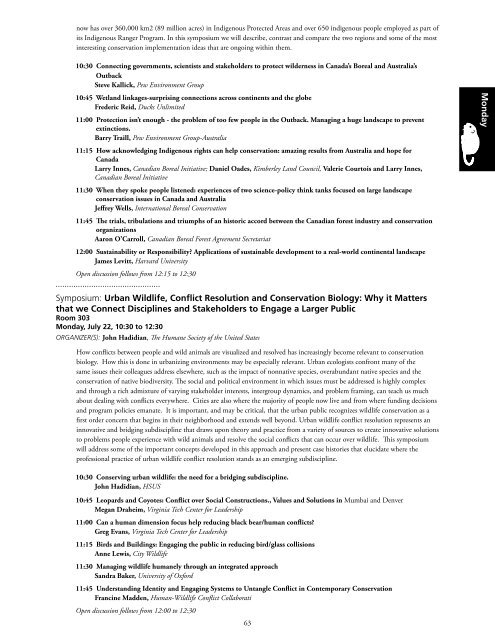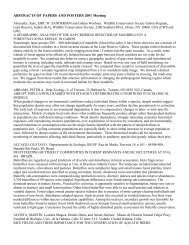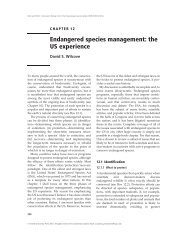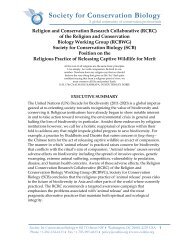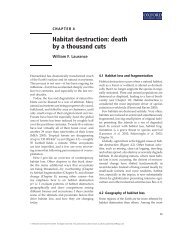ICCB 2013 Program - Society for Conservation Biology
ICCB 2013 Program - Society for Conservation Biology
ICCB 2013 Program - Society for Conservation Biology
You also want an ePaper? Increase the reach of your titles
YUMPU automatically turns print PDFs into web optimized ePapers that Google loves.
now has over 360,000 km2 (89 million acres) in Indigenous Protected Areas and over 650 indigenous people employed as part of<br />
its Indigenous Ranger <strong>Program</strong>. In this symposium we will describe, contrast and compare the two regions and some of the most<br />
interesting conservation implementation ideas that are ongoing within them.<br />
10:30 Connecting governments, scientists and stakeholders to protect wilderness in Canada’s Boreal and Australia’s<br />
Outback<br />
Steve Kallick, Pew Environment Group<br />
10:45 Wetland linkages-surprising connections across continents and the globe<br />
Frederic Reid, Ducks Unlimited<br />
11:00 Protection isn’t enough - the problem of too few people in the Outback. Managing a huge landscape to prevent<br />
extinctions.<br />
Barry Traill, Pew Environment Group-Australia<br />
Monday<br />
11:15 How acknowledging Indigenous rights can help conservation: amazing results from Australia and hope <strong>for</strong><br />
Canada<br />
Larry Innes, Canadian Boreal Initiative; Daniel Oades, Kimberley Land Council, Valerie Courtois and Larry Innes,<br />
Canadian Boreal Initiative<br />
11:30 When they spoke people listened: experiences of two science-policy think tanks focused on large landscape<br />
conservation issues in Canada and Australia<br />
Jeffrey Wells, International Boreal <strong>Conservation</strong><br />
11:45 The trials, tribulations and triumphs of an historic accord between the Canadian <strong>for</strong>est industry and conservation<br />
organizations<br />
Aaron O’Carroll, Canadian Boreal Forest Agreement Secretariat<br />
12:00 Sustainability or Responsibility Applications of sustainable development to a real-world continental landscape<br />
James Levitt, Harvard University<br />
Open discussion follows from 12:15 to 12:30<br />
...............................................<br />
Symposium: Urban Wildlife, Conflict Resolution and <strong>Conservation</strong> <strong>Biology</strong>: Why it Matters<br />
that we Connect Disciplines and Stakeholders to Engage a Larger Public<br />
Room 303<br />
Monday, July 22, 10:30 to 12:30<br />
Organizer(s): John Hadidian, The Humane <strong>Society</strong> of the United States<br />
How conflicts between people and wild animals are visualized and resolved has increasingly become relevant to conservation<br />
biology. How this is done in urbanizing environments may be especially relevant. Urban ecologists confront many of the<br />
same issues their colleagues address elsewhere, such as the impact of nonnative species, overabundant native species and the<br />
conservation of native biodiversity. The social and political environment in which issues must be addressed is highly complex<br />
and through a rich admixture of varying stakeholder interests, intergroup dynamics, and problem framing, can teach us much<br />
about dealing with conflicts everywhere. Cities are also where the majority of people now live and from where funding decisions<br />
and program policies emanate. It is important, and may be critical, that the urban public recognizes wildlife conservation as a<br />
first order concern that begins in their neighborhood and extends well beyond. Urban wildlife conflict resolution represents an<br />
innovative and bridging subdiscipline that draws upon theory and practice from a variety of sources to create innovative solutions<br />
to problems people experience with wild animals and resolve the social conflicts that can occur over wildlife. This symposium<br />
will address some of the important concepts developed in this approach and present case histories that elucidate where the<br />
professional practice of urban wildlife conflict resolution stands as an emerging subdiscipline.<br />
10:30 Conserving urban wildlife: the need <strong>for</strong> a bridging subdiscipline.<br />
John Hadidian, HSUS<br />
10:45 Leopards and Coyotes: Conflict over Social Constructions., Values and Solutions in Mumbai and Denver<br />
Megan Draheim, Virginia Tech Center <strong>for</strong> Leadership<br />
11:00 Can a human dimension focus help reducing black bear/human conflicts<br />
Greg Evans, Virginia Tech Center <strong>for</strong> Leadership<br />
11:15 Birds and Buildings: Engaging the public in reducing bird/glass collisions<br />
Anne Lewis, City Wildlife<br />
11:30 Managing wildlife humanely through an integrated approach<br />
Sandra Baker, University of Ox<strong>for</strong>d<br />
11:45 Understanding Identity and Engaging Systems to Untangle Conflict in Contemporary <strong>Conservation</strong><br />
Francine Madden, Human-Wildlife Conflict Collaborati<br />
Open discussion follows from 12:00 to 12:30<br />
63


